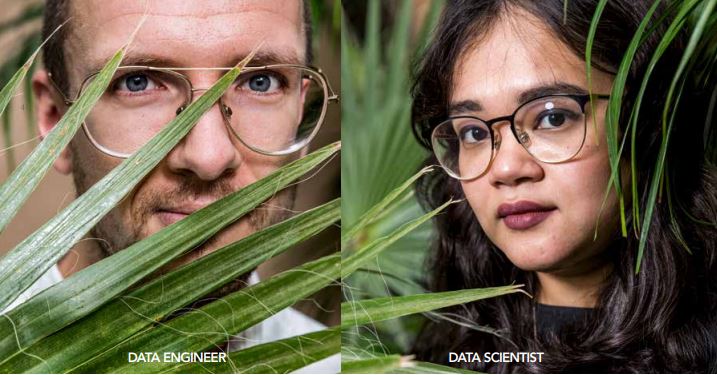
Klik hier om het interview te lezen in het Nederlands
In the December issue of KAS Magazine, Lars Geraets and Saheli De talk about their work as Data Engineer and Data Scientist at Blue Radix. With the digitization and automation of greenhouse horticulture, new and current jobs are changing. How do a Data Engineer and Data Scientist contribute to the realization of autonomous growing? You can read it below.
You can read the entire interview about how Blue Radix adds artificial intelligence to daily decisions in the greenhouse here (PDF KAS Magazine, only in Dutch).
| Lars Geraets (left) | Saheli De (right) | |
| Age | 26 | 29 |
| City | Rotterdam | Delft |
| Place of birth | Vlaardingen, Netherlands | Kharagpur, India |
| Job title | Data Engineer | Data Scientist |
| Study | Business Administration Erasmus University, Rotterdam | Bio-informatics, Saarland University |
| With Blue Radix since | April 2020 | January 2020 |
| How did you end up at Blue Radix? | After two master’s degrees (innovation and information management), I started at AgroEnergy in 2017. Among other things they focus on smart energy services for greenhouse horticulture. Last year I was approached for this job at Blue Radix, an AgroEnergy spin-off. | After my studies in India and Germany, my Dutch partner and I decided to settle in the Netherlands. Then I approached an agency to find a job as a Data Scientist – but specifically at a company with a ‘purpose’, a good cause. That’s how I ended up here. |
| Describe your job | A Data Engineer ensures that all data required by the Data Scientists is retrieved and processed into programs producing predictions for the best possible settings of greenhouse installations. It’s up to us to connect the prediction models of Saheli and her team seamlessly to all the software enabling autonomous control of the greenhouse. | The Data Science team is responsible for analyzing greenhouse data and, ultimately, for designing smart solutions for the complete automation of greenhouse processes. These data-driven solutions use advanced AI technologies like deep learning, machine learning and robotics. I’m working on several modules of Crop Controller, our service for autonomous growing. This includes modules for humidity, CO2 and setpoint optimization that automatically control the climate computer in the greenhouse. |
| Do you have a back-ground in greenhouse horticulture? | Not directly. But my father grew up on my grandfather’s mushroom farm. | No, I come from a family of scientists and engineers. I first entered a greenhouse here in the Netherlands. Wow, so huge; that was amazing! |
| How important is (your) cooperation? | Everyone has their own domain, but we can’t work without each other. So scientists and engineers are constantly looking over each other’s shoulders. We also work closely with our Crop Advisors who help growers with their strategy. And we collaborate with the Autonomous Greenhouse Manager, the personal point of contact for growers. We’re not here just to wrap-up our side of things and then leave everyone else to it! | Very important! The Data Science team work in very close cooperation with the Data Engineers, as Lars points out. We need each other. I also work a lot with Bram, our Principal Data Strategist. And we have great UI designers, product developers and a Crop Advisor; we all work together to achieve the best product! |
| Is there still some room for leisure? | You’ll find me in the gym every day. And because of my sport I’m also very busy with nutrition. With every tomato or paprika I eat, I’m actually thinking about my work to some extent! | Delft, my new hometown, is a beautiful place and I enjoy cycling here. I also like to paint. And I love photography. |
| Finally, what makes your work so fascinating? | I realize that we’re doing some very wonderful things here. Namely, coming up with sustainable solutions for global food production. And the challenge that a grower will later say: ‘Hey, I’m no longer going to control the greenhouse myself; I trust Blue Radix to do it even better!’ | Working at Blue Radix feels like working for the Tesla of greenhouse horticulture. Technology is evolving constantly. What’s good today isn’t good enough tomorrow. Because customers always want more: more functionalities and better algorithms, for example. And this is a booming business, so I believe being able to work in it and learn from it is extremely valuable to me. |